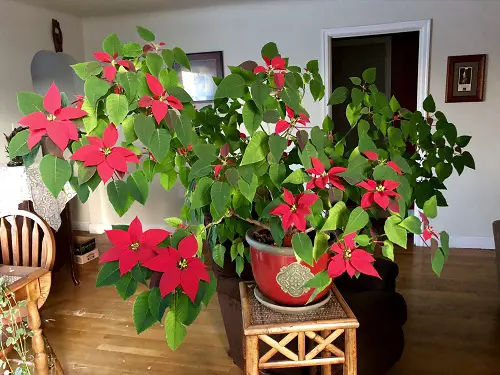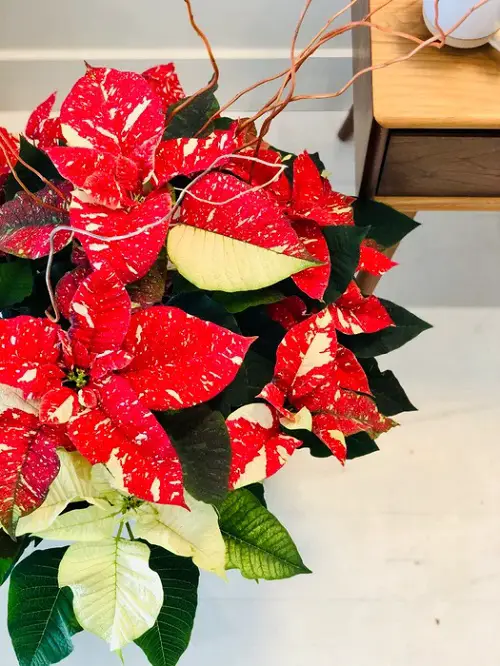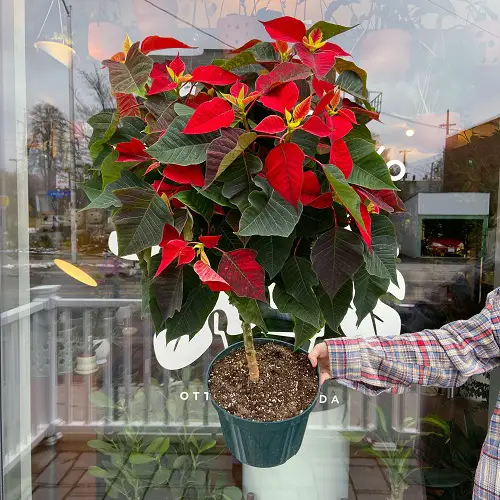These Poinsettia Care Tips After Christmas can help you maintain this houseplant for year-round greenery and beautiful red bracts.
So, the holiday season is over, and you’re left with a beautiful poinsettia that brought festive cheer into your home. Now what, should you keep it? And if so, how will you ensure it grows and becomes the center of attraction again the following fall and Christmas? Well, these Poinsettia Care Tips will come to your rescue!
Want to know the secrets of buying the BEST Poinsettia out there? Click here!
Poinsettia Care Tips After Christmas
1. Start with Pruning
Your poinsettias will love a little snip after the holidays. But here’s the catch! Wait until January, after the show of fantastic red bracts is over. The trick is to do it gently, reducing it to only 30 percent of the overall height.
Think of this as a fresh haircut, encouraging bushier growth in a compact form. Also, it will make sure it gets back to what it was, right around the festive time the next year 😉!
Well, well, well! You can use those cuttings to grow a new plant! Learn how to do that here.
2. Adjust the Light

Now you will ask – what’s next? Well, taking care of the sunlight it receives. Find a spot where the plant gets bright, indirect light. If it is kept in a dark spot in your home, gradually expose it to more light. A north- or east-facing window is perfect. Avoid harsh direct sunlight as it can scorch the leaves.
Remember, it’s like finding a new home for your poinsettia where it feels comfortable 🌿!
Do not miss these amazing poinsettia arrangement ideas!
3. Maintain Proper Temperature, Especially in Winter!
To keep your poinsettia happy, maintain a consistent temperature around them—not too cold. Ideally, between 60-75°F (15-24°C), a warm and toasty room with your radiator turned on will do this.
Also, protect it from drafts or sudden temperature swings. Don’t leave your windows open in the winter when you go to work 😉.
Think of it as creating a cozy environment for your plant 💕
4. Water Wisely
Post-Christmas period or anytime, in fact, never overwater this Euphorbia. Do it only when the top of the soil feels dry to the touch. Ensure good drainage, as poinsettias dislike sitting in waterlogged soil and don’t always keep the soil.
5. Fertilize Strategically
Remember the spot we talked about in the second point, where the plant will happily bask in just the right amount of daylight it receives? Well, when you see it enjoying itself and actively growing, that’s the time you start feeding it!
From early or mid-spring, when you notice some growth, start using a balanced, liquid fertilizer every 4-6 weeks after diluting it to 1/4 to 1/2 of its recommended strength.
Go easy on the fertilizer until it’s cold outside, my friend! Make sure it’s warm before you start.
6. Re-pot, if required
While it’s better to keep this plant slightly root-bound if your poinsettia has really outgrown its container (When you see the roots popping out from the drainage hole at the bottom, or you see them on the topsoil), re-pot it in the spring (In one size larger pot than the older one – remember, not more than that!).
7. Encourage Bushier Growth

To keep your plant bushy and full, gently pinch back the growing tips throughout the summer months. This encourages side shoots and a lush, compact form.
See the image, folks! You can get the same one with this tip 😎!
Do you know you can also grow a poinsettia as big as a tree? Click here to know how.
8. And the Secret for Next Year!
While poinsettias need ample light during the day, they have a secret: they thrive in complete darkness during the night.
About 12-14 hours of uninterrupted darkness each night from late September to early December encourages the striking red bracts to form. So, if you’re aiming for those vibrant hues next holiday season, create a dark, cozy nook for your poinsettia during the suggested period.




